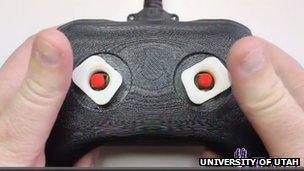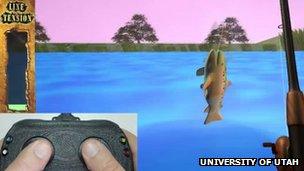Thumb-stretching controller pitched to console makers
- Published

The controller's thumbsticks only move if a game's software has been written specifically for it
A video games controller which pulls and stretches the skin of its users' thumbs has been unveiled in Canada.
Developers said theirprototype provided extra feedback, externalabout game characters' actions.
For example they said the device could mimic the recoil of a gun or the motion of a boat on water better than what could currently by achieved by vibrating a controller.
The device is being pitched to Microsoft among other console makers.
Engineers from the University of Utah showed off the device at the Haptics Symposium in Vancouver - a conference organised to highlight the latest research into the sense of touch.
"In the centre of the thumbsticks there's a little contact bud that is similar to what you have on a Thinkpad laptop - a little red dot," Prof William Provancher from the university's department of mechanical engineering told the BBC.
"In our case that dot moves, and when it moves it provides touch feedback which allows us to enhance sensations such as gunfire.
"The feeling is very similar to what you get if you place your finger down on a table top and drag it across - it stretches the skin. In this particular case the tugging on your skin is happening because of the motion-device mechanism beneath the thumbsticks."
Fishing thumbs
So far the researchers said they had built a library of five tactile effects: bounce, pulse, a circular movement, a wave effect and the feeling of crawling along the ground.
In addition they said the thumbsticks could be used to give directional cues drawing users' attention to part of the gaming environment.
To demonstrate their invention the researchers have created Feelin' Fishy - a simulation which causes the thumbsticks to sway side to side, imitating waves pulling on a fishing line.
The controller also stretches the skin of users' right thumbs to signal when they should try to hook a fish, and then emulates it tugging against the rod.
The team is also developing a music-based title in which the sticks' motion is linked to the tones being played - the higher the note the faster they move.

Researchers say the thumbsticks can be used to signal what actions should be carried out
Army remote controls
The controller was developed as part of a three year research study funded with a $150,000 (£94,530; 113,360 euros) research grant from the US-based National Science Foundation. It evolved out of a project which originally focused on building a steering wheel designed to send signals to one hand or the other to tell drivers to turn left or right.
Although the engineers are now focused on video games, Prof Provancher said the device might still have real world uses.
"The military have started using game controllers to interact with things like robots and unmanned vehicles," he said.
"So for instance if it's a robot that's on the ground it could be information about obstacles in the environment, or if it was a drone aircraft flying over doing surveillance perhaps it's processing the information and giving a cue to the remote pilot to focus their attention on something interesting."
Compatibility issues
Prof Provancher said he had already shown the device to Microsoft researchers and had been asked to give a more detailed presentation at the firm's Redmond headquarters.
He also hopes to attract further interest when he attends the Game Developers Conference in San Francisco later this week.
If one of the console manufacturers decides to license the technology, the professor said he expects the thumbsticks will add about £10 to the retail price of a controller.
However, if he fails to win over one of the console makers the innovation is likely to struggle since it depends on software being written specifically for it and does not give motion feedback for other games.
- Published8 March 2012
- Published28 November 2011
- Published7 June 2011